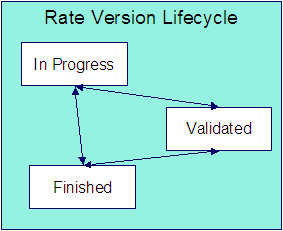Lifecycle of a Rate Version
The following diagram shows the possible lifecycle of a rate version (you'll notice that you can change a rate version from any state to any state).

A rate version is in the In Progress state while you build its rate components. While a rate version is in this state, the system does not cross validate among rate components because they are added, changed, or deleted using Rate Component Maintenance and/or Rate Version Merge. However, the system will perform inter-field validation applicable to each type of rate component. Rate versions in this state may not be used by Rate Check, nor will they be used up by the billing process.
You transition a rate version to the Validated state when you're ready to check it using Rate Check, but you don't want billing to use it to calculate charges. When a rate version is transitioned to this state, the system performs cross validation among its rate components. If any validation errors are found, an error message is displayed and the status remains In Progress. If all validation checks are passed, the rate version status will become Validated. We'd like to stress that rate versions in this state may be used by Rate Check, but will not be used by billing.
You transition a rate version to the Finished state when it can be used by billing to calculate charges. All of the cross validation between rate components will be performed when transitioning to this state.
Finished and Validated states also affect rate component maintenance. If a rate version is Finished or Validated, the system performs internal consistency checks every time a rate component is added, changed or deleted using Rate Component Maintenance and/or Rate Version Merge. If you don't want these checks to be performed while you're working on a rate version's rate components, change its state to In Progress.
